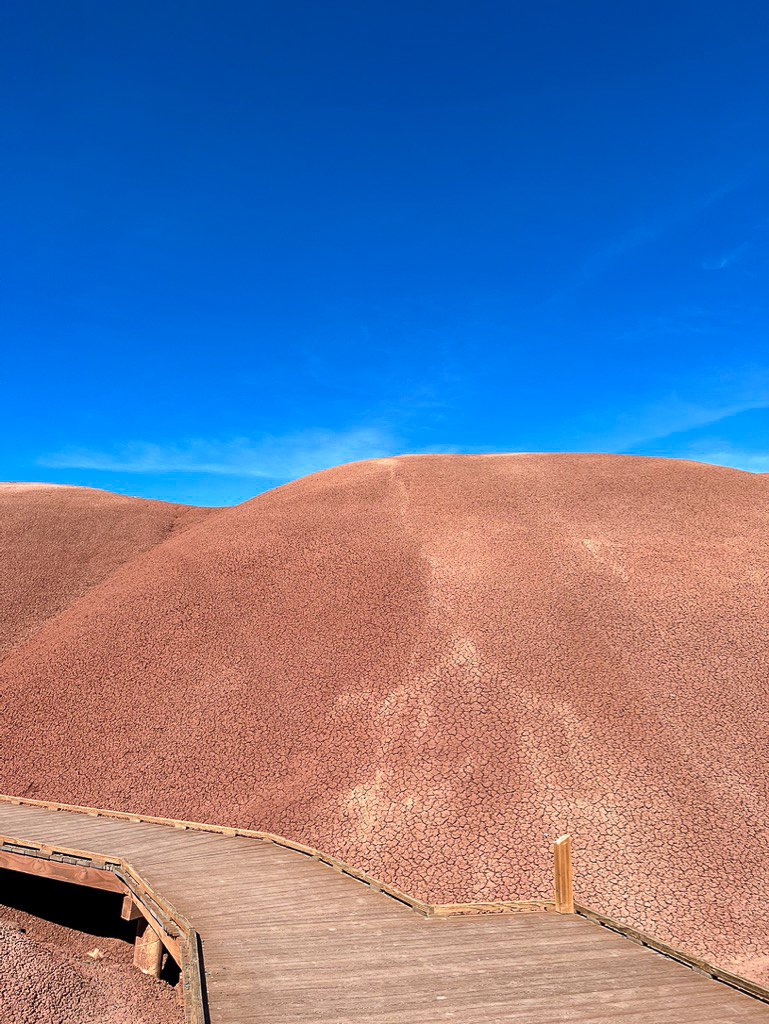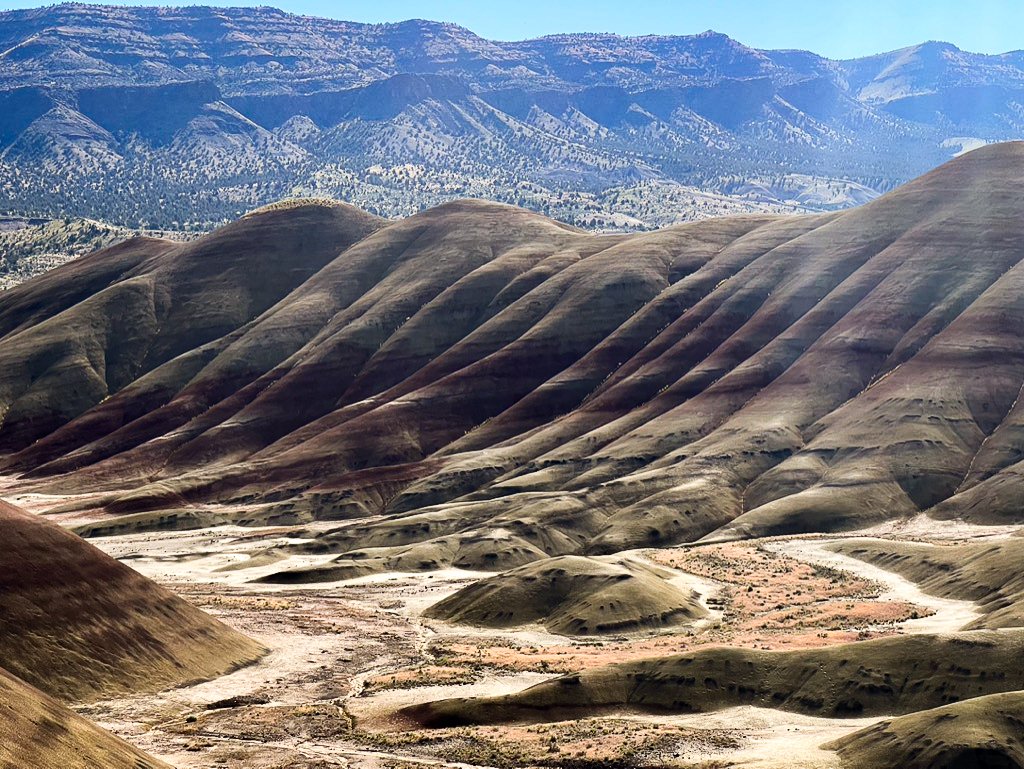Painted Hills National Monument
Eastern Oregon’s painted Hills are one of ‘The Seven Wonders of Oregon’, and for good reason. This incredible landscape is home to some of the most stunning geological formations you'll ever see, and it's also steeped in a rich history that dates back thousands of years. They are one of the three units of the John Day Fossil Beds National Monument and offer a rugged, vivid landscape reminiscent of a time long, long ago.
The fascinating geology of The Painted Hills are artistic revelations of climate change on Earth. The colored banded deposits represent changes in climate that occurred at the time they were formed.
Painted Hills National Monument is nearest the town of Mitchell, Oregon. The area is great for hiking, camping, exploring, and of course, photography. Mornings and evenings offer special opportunities to see the colors of the Painted Hills illuminated by the light of sunrise and sunset.
-
-
Camp at Ochoco Divide or other nearby campsites listed here.
Many campsites in this area are primitive, meaning they do not have water or toilets. Prepare accordingly and ALWAYS HAVE WATER.
-
Check out the delicious Tiger Town Brewery in Mitchell, Oregon.
-
Dogs are allowed on leash.
Painted Hills National Monument
Located in Wheeler County, Oregon, Painted Hills National Monument is one of three units of the John Day Fossil Beds National Monument. The park is known for its incredibly vibrant and colorful hills, which are made up of layers of sedimentary rock that tell the story of the area's geological past.
In addition to the hills, the park is home to numerous hiking trails, picnic areas, and opportunities to view wildlife and plant life that are unique to the region.
The Geology of Painted Hills National Monument
The hills themselves are the main attraction at Painted Hills National Monument, and for good reason. The layers of rock that make up the hills are incredibly diverse, ranging from bright reds and oranges to deep purples and blues.
These colors are the result of millions of years of sediment deposition, uplift, and erosion. The different colors and patterns of the hills represent different geological eras and environmental conditions, making them a fascinating subject for geologists and rock enthusiasts alike.
One of the most interesting things about the geology of Painted Hills National Monument is that it represents a snapshot of time from over 30 million years ago. During this time period, the area was home to a vast, subtropical forest that was filled with ancient plants and animals. Over time, volcanic activity and changes in the environment caused the forest to disappear, leaving behind the layers of rock that we see today.
The Formation of Painted Hills National Monument
As mentioned, the hills at Painted Hills National Monument were formed over millions of years through a process of sediment deposition, uplift, and erosion. The area was once covered in a shallow lake, which deposited layers of sediment that eventually turned into the rock formations we see today. Over time, the land was uplifted and the layers of rock were exposed to erosion from wind and water, creating the unique patterns and colors that we see today.
The process of erosion is ongoing, which means that the hills at Painted Hills National Monument are constantly changing. While this can be frustrating for geologists who want to study the rocks in their original state, it's also what makes the area so dynamic and interesting to visit.
The History of Painted Hills National Monument
While the geological history of Painted Hills National Monument is fascinating, the human history of the area is equally rich. The region has been home to indigenous peoples for thousands of years, and evidence of their presence can be seen in the form of rock art, tools, and other artifacts.
Many of these artifacts are now on display at the Thomas Condon Paleontology Center, which is located in the park and offers a wealth of information about the history and geology of the area.
The First Nation Connection to Painted Hills National Monument
The indigenous peoples who have lived in the area around Painted Hills National Monument for thousands of years have a deep connection to the land and its history.
The ancestors of modern-day First Nation, including the Confederated Peoples of Warm Springs and the Confederated Peoples of the Umatilla Native Reservation, have lived in the area and continue to do so today.
These indigenous groups have a deep understanding of the land and its history, and they have played an important role in preserving the natural and cultural resources of the area.
The Role of Paleontology in Painted Hills National Monument
Paleontology, the study of ancient life, plays an important role in understanding the history of Painted Hills National Monument.
The Thomas Condon Paleontology Center, which is located within the park, is home to a wealth of fossils and other artifacts that offer a glimpse into the ancient past of the region.
This includes fossils of ancient plants and animals that once lived in the area, as well as evidence of the early human inhabitants who lived alongside them.
The Flora and Fauna of Painted Hills National Monument
In addition to its stunning geological formations, Painted Hills National Monument is home to a variety of unique plant and animal life.
The park is home to several species of sagebrush, which are adapted to the dry, arid climate of the region.
Visitors can also spot a variety of wildlife, including deer, elk, and coyotes, as well as numerous bird species. One of the most interesting animals in the area is the pronghorn, a species of antelope that is unique to North America.
Visiting Painted Hills National Monument: What to Expect
If you're planning a trip to Painted Hills National Monument, there are a few things to keep in mind. The park is open year-round, but the best time to visit is during the spring or fall when the temperatures are mild and the crowds are smaller. Be sure to pack plenty of water and sunscreen, as the park can get very hot during the summer months.
There are several hiking trails in the park that offer stunning views of the hills and surrounding landscape. If you're interested in learning more about the history and geology of the area, be sure to visit the Thomas Condon Paleontology Center, which offers exhibits and educational programs for visitors of all ages.
Tips for Exploring Painted Hills National Monument
To make the most of your visit to Painted Hills National Monument, here are a few tips to keep in mind:
Wear comfortable hiking shoes and dress in layers, as the weather can change quickly
Pack plenty of water and snacks, as there are no food or drink vendors within the park
Take your time and explore the different trails and overlooks to get a full appreciation of the area's beauty and history
Be respectful of the natural and cultural resources of the area, and follow all park rules and regulations
Why Painted Hills National Monument is a Must-See Destination
Painted Hills National Monument is a truly unique and fascinating destination that offers a glimpse into the geological and human history of the region.
Whether you're a geology buff, a nature lover, or just looking for a beautiful and inspiring place to explore, this park has something for everyone.
With its stunning hills, diverse plant and animal life, and rich cultural history, Painted Hills National Monument is truly a must-see destination.
Hike
Camp
Camp at Ochoco Divide.
Many campsites in this area are primitive, meaning they do not have water or toilets. Prepare accordingly and ALWAYS HAVE WATER.
Food and Drink
Check out the delicious Tiger Town Brewery in Mitchell, Oregon or grab an amazing espresso at Route 26 Espresso.


























































